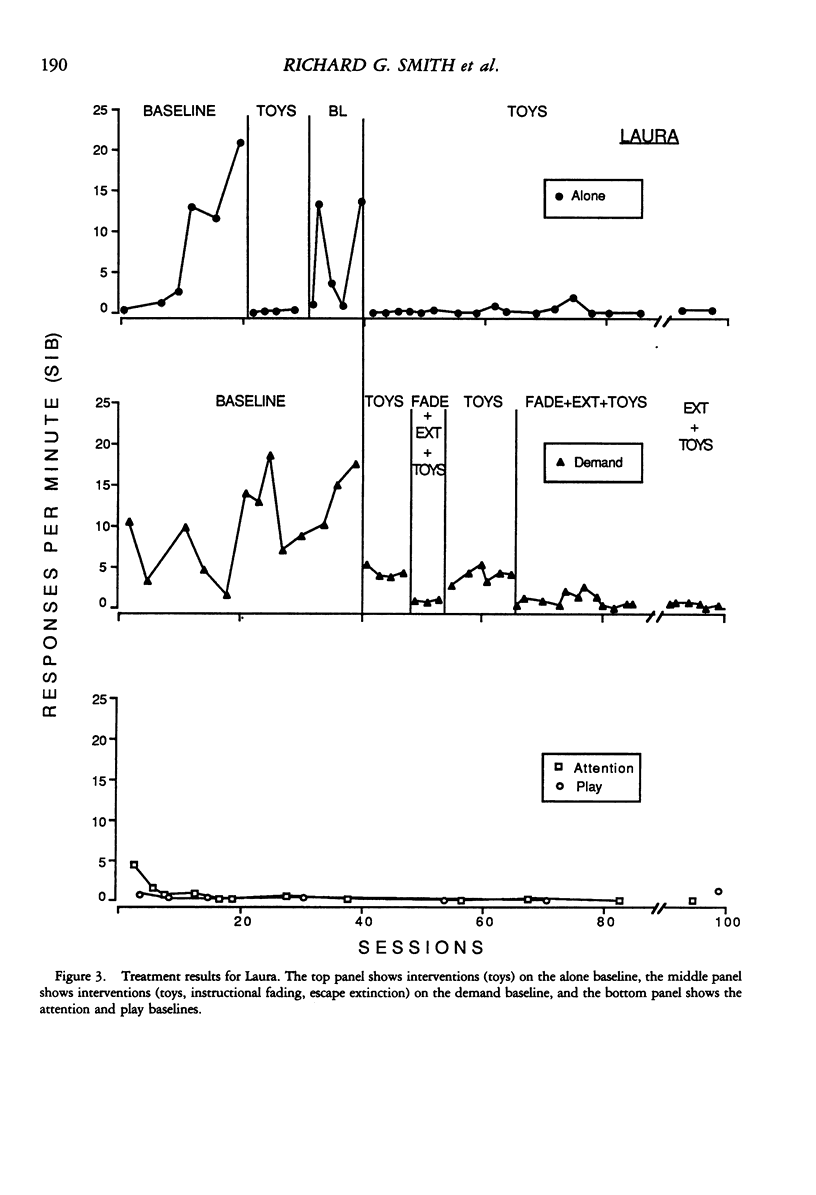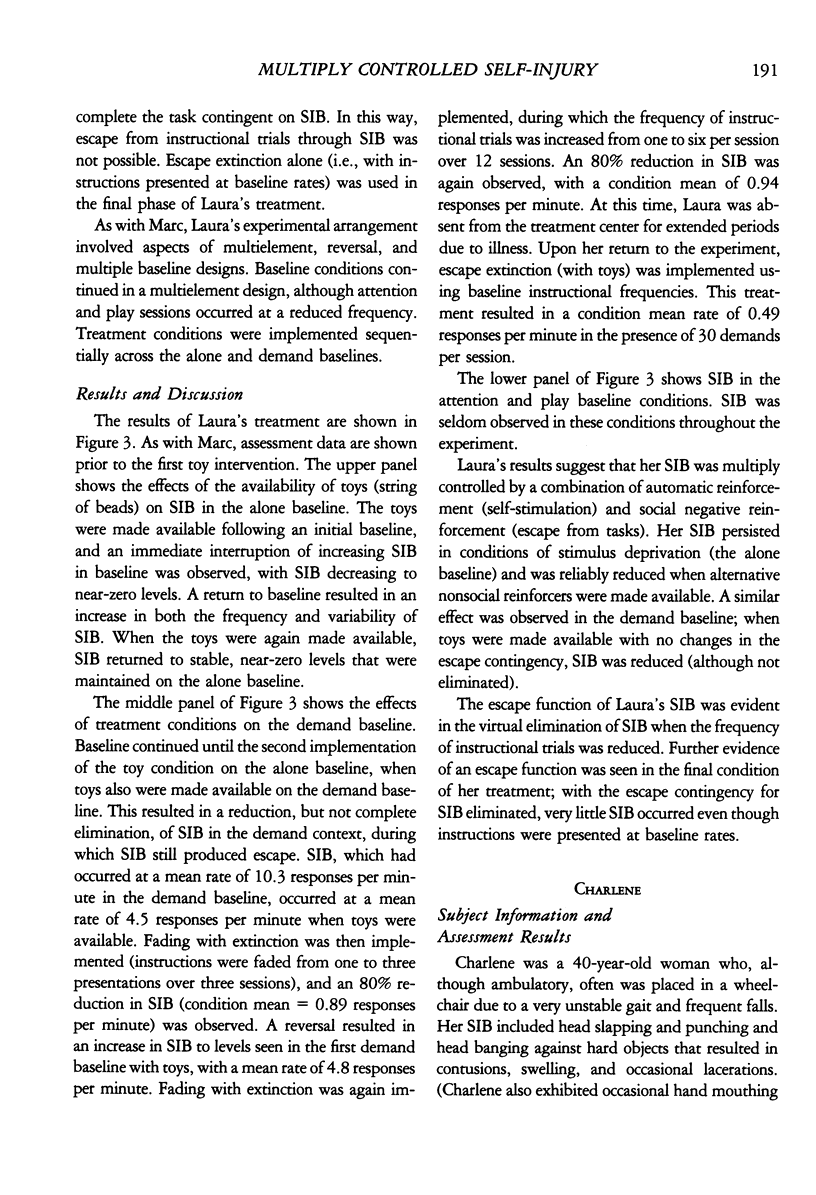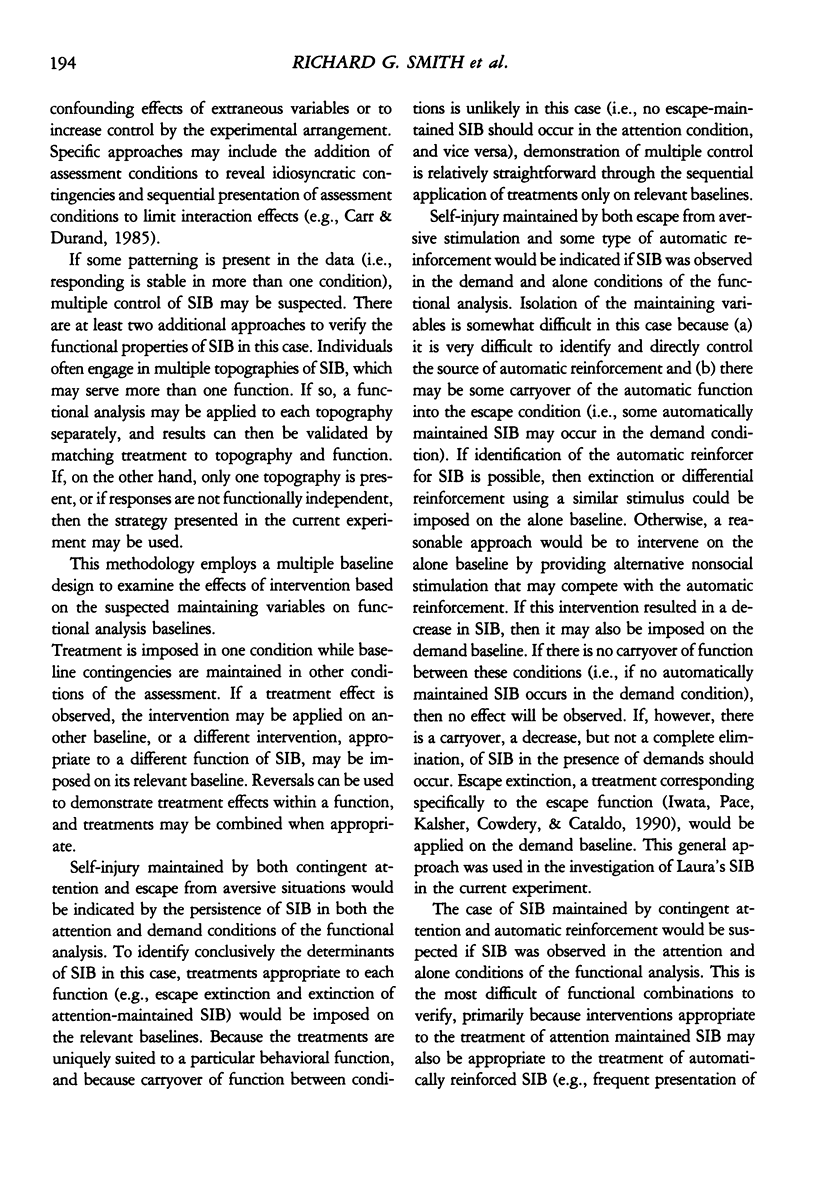Abstract
A functional analysis of the self-injurious behavior (SIB) of 3 adults with profound developmental disabilities showed that each engaged in SIB in more than one assessment condition. Such outcomes may result from a failure to isolate the variable maintaining SIB, or they may reflect multiple sources of control over SIB. In order to identify more clearly the determinants of SIB, each subject was exposed to a series of treatments appropriate to one or both of the apparent functions of SIB. These treatments, applied sequentially on baselines appropriate to each behavioral function, identified the maintaining variables for SIB through differential outcomes across baselines. Results indicated that the SIB of 2 subjects was multiply controlled, confirming the outcomes of the functional analysis. However, the SIB of the 3rd subject was eliminated using a treatment designed for a single function, suggesting spurious results of the original assessment. Alternative interpretations of undifferentiated assessment data are discussed, as are analysis and treatment issues related to multiply determined behavior disorders.
Full text
PDF













Selected References
These references are in PubMed. This may not be the complete list of references from this article.
- Carr E. G., Durand V. M. Reducing behavior problems through functional communication training. J Appl Behav Anal. 1985 Summer;18(2):111–126. doi: 10.1901/jaba.1985.18-111. [DOI] [PMC free article] [PubMed] [Google Scholar]
- Carr E. G., Newsom C. D., Binkoff J. A. Stimulus control of self-destructive behavior in a psychotic child. J Abnorm Child Psychol. 1976;4(2):139–153. doi: 10.1007/BF00916518. [DOI] [PubMed] [Google Scholar]
- Day R. M., Rea J. A., Schussler N. G., Larsen S. E., Johnson W. L. A functionally based approach to the treatment of self-injurious behavior. Behav Modif. 1988 Oct;12(4):565–589. doi: 10.1177/01454455880124005. [DOI] [PubMed] [Google Scholar]
- Green L., Rachlin H. Economic substitutability of electrical brain stimulation, food, and water. J Exp Anal Behav. 1991 Mar;55(2):133–143. doi: 10.1901/jeab.1991.55-133. [DOI] [PMC free article] [PubMed] [Google Scholar]
- Heidorn S. D., Jensen C. C. Generalization and maintenance of the reduction of self-injurious behavior maintained by two types of reinforcement. Behav Res Ther. 1984;22(5):581–586. doi: 10.1016/0005-7967(84)90062-7. [DOI] [PubMed] [Google Scholar]
- Horner R. D. The effects of an environmental "enrichment" program on the behavior of institutionalized profoundly retarded children. J Appl Behav Anal. 1980 Fall;13(3):473–491. doi: 10.1901/jaba.1980.13-473. [DOI] [PMC free article] [PubMed] [Google Scholar]
- Iwata B. A., Pace G. M., Kalsher M. J., Cowdery G. E., Cataldo M. F. Experimental analysis and extinction of self-injurious escape behavior. J Appl Behav Anal. 1990 Spring;23(1):11–27. doi: 10.1901/jaba.1990.23-11. [DOI] [PMC free article] [PubMed] [Google Scholar]
- Mace F. C., Lalli J. S., Lalli E. P. Functional analysis and treatment of aberrant behavior. Res Dev Disabil. 1991;12(2):155–180. doi: 10.1016/0891-4222(91)90004-c. [DOI] [PubMed] [Google Scholar]
- Pace G. M., Ivancic M. T., Edwards G. L., Iwata B. A., Page T. J. Assessment of stimulus preference and reinforcer value with profoundly retarded individuals. J Appl Behav Anal. 1985 Fall;18(3):249–255. doi: 10.1901/jaba.1985.18-249. [DOI] [PMC free article] [PubMed] [Google Scholar]
- Pace G. M., Iwata B. A., Cowdery G. E., Andree P. J., McIntyre T. Stimulus (instructional) fading during extinction of self-injurious escape behavior. J Appl Behav Anal. 1993 Summer;26(2):205–212. doi: 10.1901/jaba.1993.26-205. [DOI] [PMC free article] [PubMed] [Google Scholar]
- Vollmer T. R., Iwata B. A. Differential reinforcement as treatment for behavior disorders: procedural and functional variations. Res Dev Disabil. 1992;13(4):393–417. doi: 10.1016/0891-4222(92)90013-v. [DOI] [PubMed] [Google Scholar]


